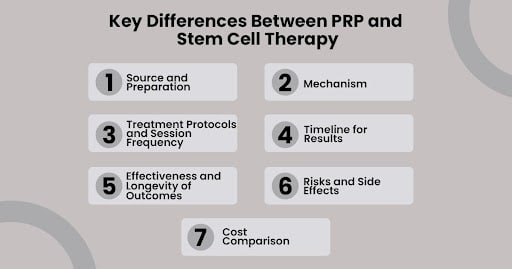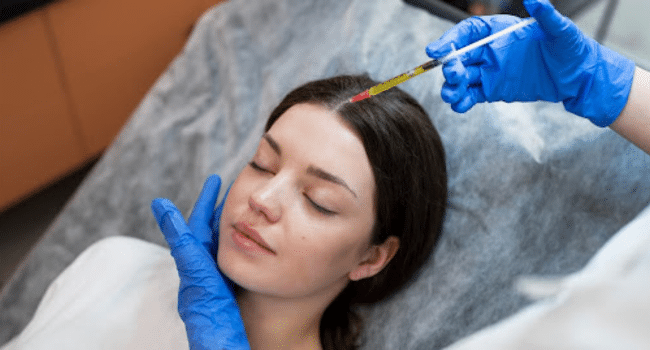Table of Contents
Hair loss can be distressing, but modern treatments like PRP hair treatment Dubai and Stem Cell Therapy offer promising solutions. Both methods use the body’s natural healing powers to promote hair growth, yet they work in very different ways. PRP therapy uses your own blood to stimulate hair follicles.
Stem cell therapy taps into powerful regenerative cells to rebuild damaged scalp tissue. Choosing the right treatment depends on the type and stage of hair loss, budget, and personal goals. Understanding how each therapy works can help you make an informed decision for healthier, thicker hair.
What is PRP Therapy for Hair?
PRP (Platelet-Rich Plasma) therapy is a medical aesthetic treatment that uses a patient’s own blood to promote healing and hair growth. A small amount of blood is usually drawn from the arm and put in a centrifuge to spin rapidly, which separates the platelet-rich plasma from other blood cells. This plasma contains a high concentration of platelets, which stimulate tissue repair and regeneration as they are rich in growth factors.
What is Stem Cell Therapy for Hair?
Stem Cell Therapy for hair is a treatment done using special cells called stem cells. These cells are often extracted from the patient’s own fat tissue or bone marrow. The collected stem cells are first purified and then injected into the scalp areas affected by hair loss. Stem cells effectively repair damaged hair follicles and encourage the growth of new, healthy hair. It also renews the scalp’s natural regenerative abilities. Unlike other treatments, stem cell therapy specifically targets the root cause and rebuilds the tissue to improve scalp health.
Key Differences Between PRP and Stem Cell Therapy

Here are some key differences between PRP treatment for hair and stem cell therapy.
1. Source and Preparation
PRP therapy obtains its healing components from the patient’s own blood. A small blood sample is drawn and spun in a centrifuge to separate the platelet-rich plasma, which contains concentrated growth factors. Stem Cell Therapy, on the other hand, uses special stem cells harvested mainly from a patient’s fat tissue or bone marrow through a small biopsy.
These stem cells are then isolated and purified before being injected back into the scalp. While PRP preparation is simpler and less invasive, stem cell therapy requires tissue extraction and more complex processing. Both treatments use the patient’s own biological materials, reducing the risk of rejection or allergic reaction, but differ significantly in how their regenerative contents are collected and prepared.
2. Mechanism
PRP works by releasing growth factors from platelets that stimulate blood flow and encourage dormant hair follicles to become active and produce thicker hair. These growth factors help repair and strengthen existing hair follicles. Stem Cell Therapy uses multipotent stem cells that can develop into different cell types. When injected into the scalp, these stem cells help regenerate damaged hair follicles.
It also encourages the creation of new hair follicles and tissue repair. Unlike PRP, stem cells provide a deeper regenerative effect by rebuilding hair structures at a cellular level. This makes stem cell therapy more comprehensive in addressing hair loss causes.
3. Treatment Protocols and Session Frequency
PRP therapy usually requires multiple sessions, often three or four treatments spaced about a month apart. After the initial series, maintenance sessions are recommended every three to six months to keep results fresh. Stem Cell Therapy generally involves fewer sessions; sometimes, just a single treatment is enough.
Although some protocols may include a follow-up after several months. Maintenance sessions for stem cells are less frequent because their regenerative impact tends to last longer. The simpler preparation of PRP allows for more regular treatments, while stem cell procedures are more intensive and spaced further apart.
4. Timeline for Results
Patients receiving PRP typically start to notice hair improvements within three to six months after the first treatment, as the platelets stimulate follicle renewal gradually. Hair often appears thicker and fuller as growth cycles stabilize. Stem Cell Therapy results tend to appear more slowly.
It commonly shows noticeable changes between six to twelve months post-treatment. Because stem cells promote deeper tissue regeneration, the effects may continue improving for longer periods. Both methods require patience, but stem cell treatment offers longer-lasting progress despite a slower initial response.
5. Effectiveness and Longevity of Outcomes
PRP therapy is effective at strengthening existing hair follicles and improving hair density, especially in early hair loss stages. Studies show PRP can improve hair growth by up to 50%. However, results may require ongoing treatments to maintain. Stem Cell Therapy has the potential to regenerate damaged follicles and create new ones.
It leads to longer-lasting hair restoration and tends to be more effective in advanced hair loss cases, and may reduce the need for frequent follow-ups. The regenerative abilities of stem cells can provide sustained improvement over the years, making it a promising option for those seeking durable hair recovery.
6. Risks and Side Effects
PRP treatment carries minimal risks since it uses the patient’s own blood. Side effects usually include mild discomfort during injections, temporary swelling, redness, or slight bruising. Stem Cell Therapy involves more invasive steps, such as tissue extraction.
It can increase the risk of infection, bleeding, or nerve damage during the biopsy. There is also a very small risk linked to stem cells involving abnormal cell growth, though this is rare. Both treatments are generally safe, but stem cell therapy requires more careful handling and experienced providers to minimize possible complications.
7. Cost Comparison
The best PRP hair treatment in Dubai is generally more affordable compared to stem cell treatments. The cost of a single PRP session typically ranges between AED 600 and AED 900, depending on the clinic and the expertise of the specialist. Most patients undergo a series of treatments, with packages for three sessions costing around AED 1,200 and six sessions about AED 2,300.
On the other hand, Stem Cell Therapy is much more expensive due to the complex process of harvesting and preparing stem cells. One session can cost anywhere from AED 11,000 to AED 37,000 or more, based on the clinic and treatment specifics. The higher cost reflects the advanced technology and skills required. Patients in Dubai should consider their budget and treatment goals carefully when choosing between more affordable, frequent PRP sessions and fewer but pricier stem cell procedures.
Ideal Candidates for both Treatments
When deciding between PRP and Stem Cell Therapy for hair loss, several factors should be considered.
- PRP therapy is best suited for:
- It is ideal for people who want minimal side effects.
- Individuals experiencing early to moderate hair thinning.
- PRP helps strengthen existing hair follicles and improve overall hair health.
- It works well for those looking for a less invasive, more affordable, and safer option.
Stem Cell Therapy is ideal for:
- People with more advanced or stubborn hair loss.
- It offers deeper tissue regeneration and longer-lasting results.
- It repairs damaged follicles and encourages new hair growth.
- Ideal for people who want expensive treatment and handle complex procedures.
Conclusion
PRP and Stem Cell Therapy both provide effective alternatives to traditional hair restoration options. PRP is ideal for early-stage hair thinning and offers a safer, more affordable option with quick recovery times. Stem Cell Therapy works deeply to regenerate hair follicles and is suited for more advanced hair loss, promising longer-lasting results.
While stem cell treatments can be pricier and require specialized care, they may reduce the need for frequent sessions. Ultimately, booking a consultation with the best aesthetic clinic in Dubai, like Halcyon Aesthetic Clinic, is key to choosing the best option based on individual hair loss severity, health, and budget, ensuring a personalized path to renewed confidence through natural hair regrowth.
